Organisational Behaviour Report: John Lewis Case Analysis
VerifiedAdded on 2023/01/11
|20
|6515
|99
Report
AI Summary
This report provides a comprehensive analysis of organizational behaviour, focusing on the case of John Lewis. It begins with an exploration of organizational culture, including Handy's cultural model (power, role, task, and person cultures), and its impact on individual and team performance. The report then delves into the influence of power dynamics, examining different types of power (referent, legitimate, expert, coercive, and reward) and their effects on employee motivation and behaviour within the organization. Furthermore, the report analyzes organizational politics, differentiating between good and bad politics and their consequences. The analysis extends to motivation theories, comparing content theories (McClelland's Need Theory) and process theories (Adam's Equity Theory) to understand employee motivation at John Lewis. The report also explores the characteristics of effective versus ineffective teams, followed by an application of organizational behaviour concepts and philosophies to a given business situation. Overall, the report offers insights into how these elements interact to shape organizational outcomes and employee experiences at John Lewis.
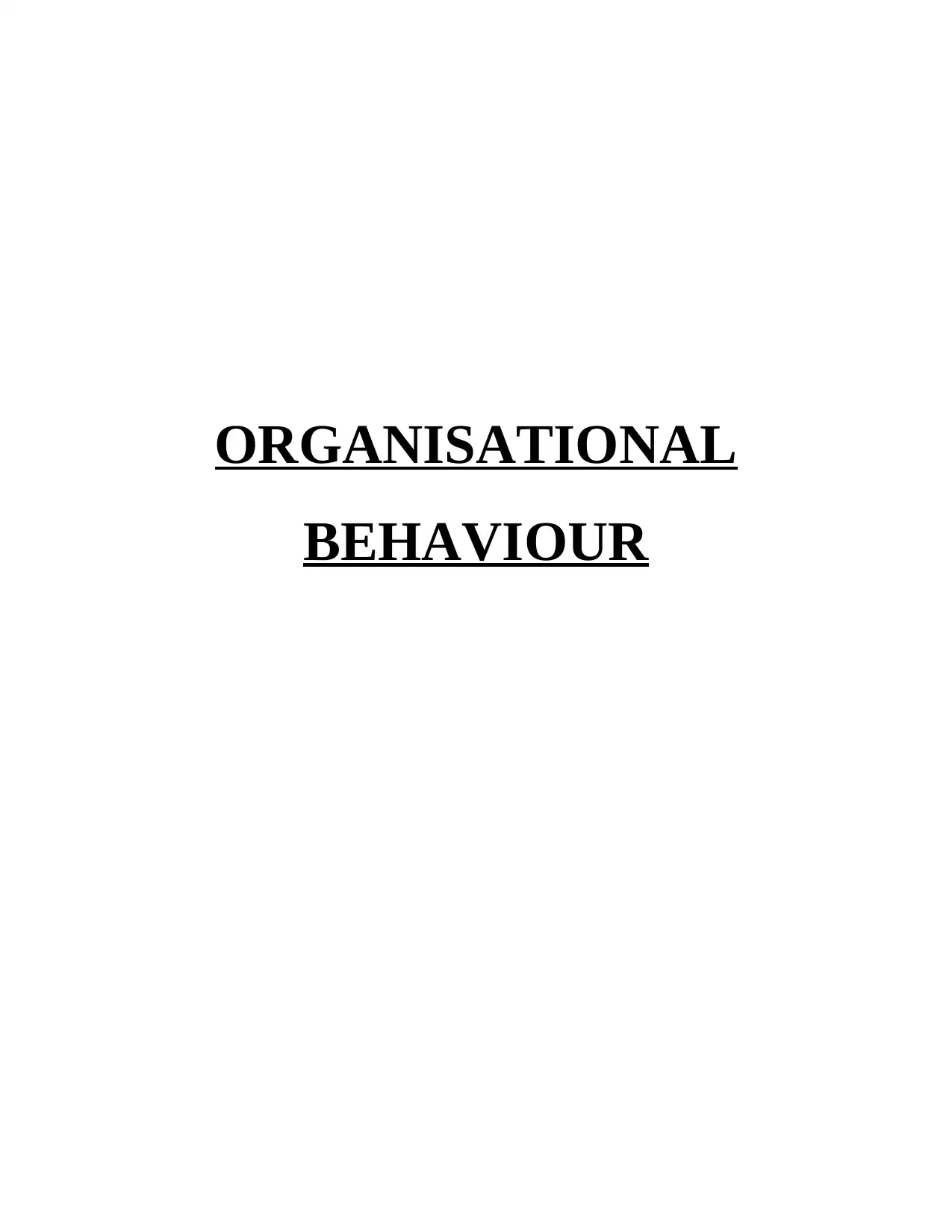
ORGANISATIONAL
BEHAVIOUR
BEHAVIOUR
Paraphrase This Document
Need a fresh take? Get an instant paraphrase of this document with our AI Paraphraser
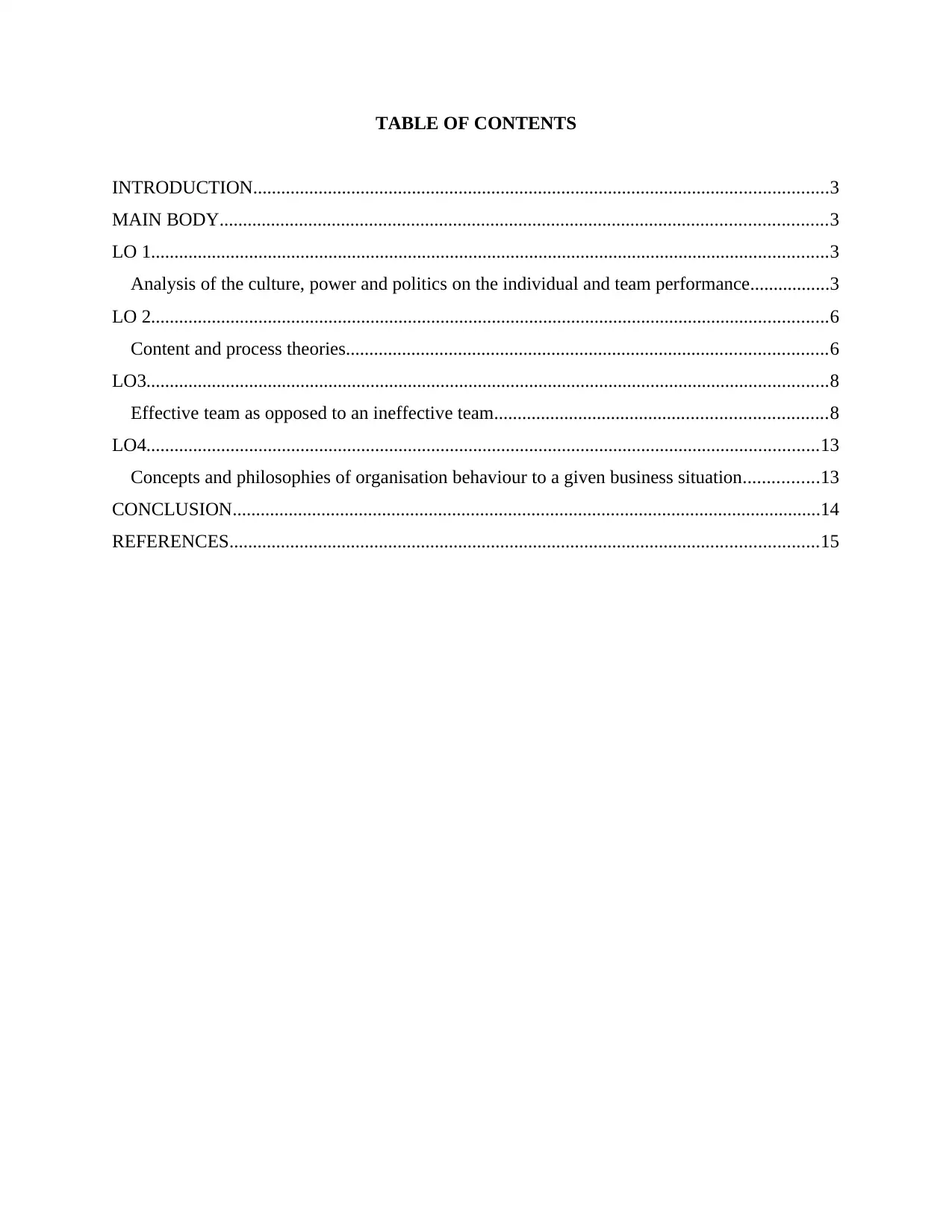
TABLE OF CONTENTS
INTRODUCTION...........................................................................................................................3
MAIN BODY..................................................................................................................................3
LO 1.................................................................................................................................................3
Analysis of the culture, power and politics on the individual and team performance.................3
LO 2.................................................................................................................................................6
Content and process theories.......................................................................................................6
LO3..................................................................................................................................................8
Effective team as opposed to an ineffective team.......................................................................8
LO4................................................................................................................................................13
Concepts and philosophies of organisation behaviour to a given business situation................13
CONCLUSION..............................................................................................................................14
REFERENCES..............................................................................................................................15
INTRODUCTION...........................................................................................................................3
MAIN BODY..................................................................................................................................3
LO 1.................................................................................................................................................3
Analysis of the culture, power and politics on the individual and team performance.................3
LO 2.................................................................................................................................................6
Content and process theories.......................................................................................................6
LO3..................................................................................................................................................8
Effective team as opposed to an ineffective team.......................................................................8
LO4................................................................................................................................................13
Concepts and philosophies of organisation behaviour to a given business situation................13
CONCLUSION..............................................................................................................................14
REFERENCES..............................................................................................................................15
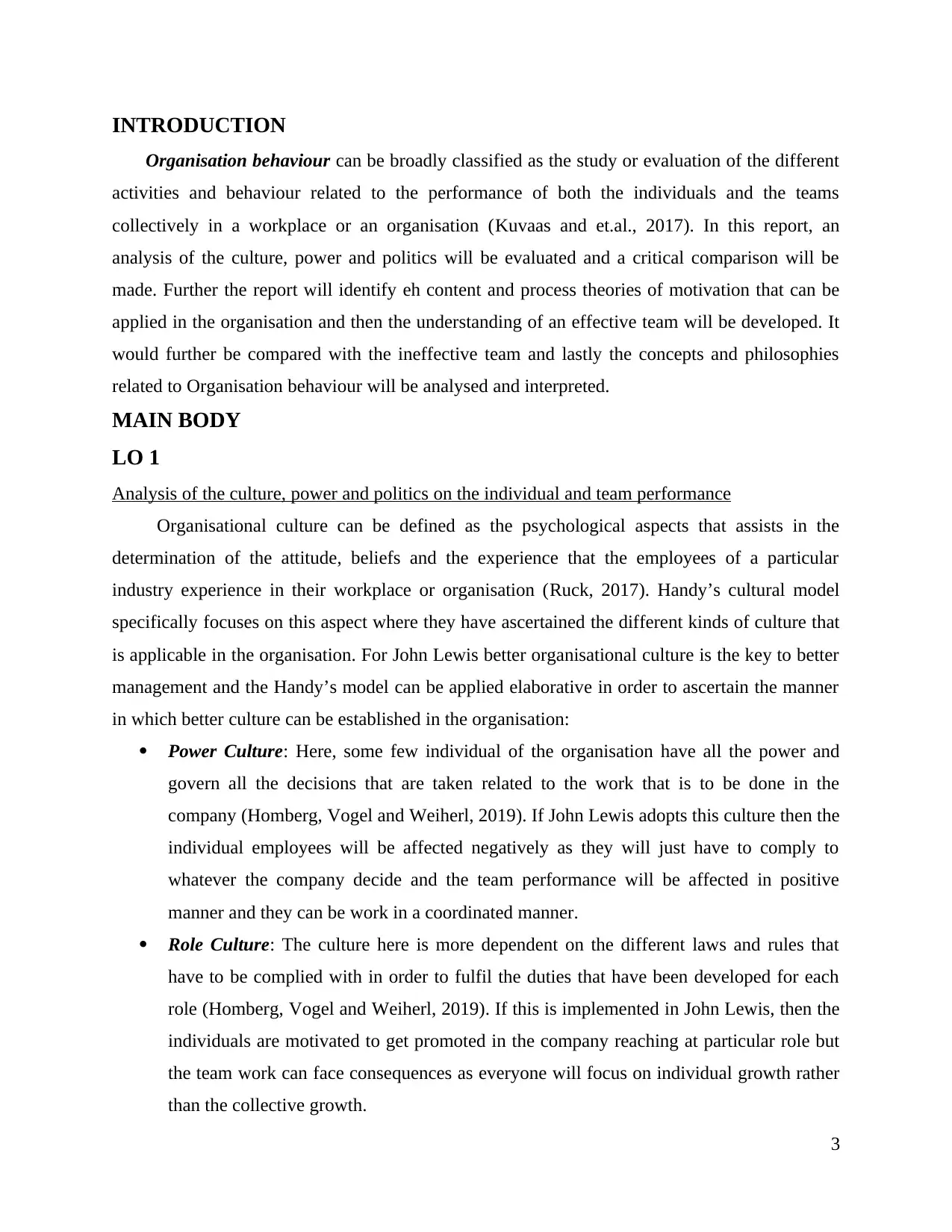
INTRODUCTION
Organisation behaviour can be broadly classified as the study or evaluation of the different
activities and behaviour related to the performance of both the individuals and the teams
collectively in a workplace or an organisation (Kuvaas and et.al., 2017). In this report, an
analysis of the culture, power and politics will be evaluated and a critical comparison will be
made. Further the report will identify eh content and process theories of motivation that can be
applied in the organisation and then the understanding of an effective team will be developed. It
would further be compared with the ineffective team and lastly the concepts and philosophies
related to Organisation behaviour will be analysed and interpreted.
MAIN BODY
LO 1
Analysis of the culture, power and politics on the individual and team performance
Organisational culture can be defined as the psychological aspects that assists in the
determination of the attitude, beliefs and the experience that the employees of a particular
industry experience in their workplace or organisation (Ruck, 2017). Handy’s cultural model
specifically focuses on this aspect where they have ascertained the different kinds of culture that
is applicable in the organisation. For John Lewis better organisational culture is the key to better
management and the Handy’s model can be applied elaborative in order to ascertain the manner
in which better culture can be established in the organisation:
Power Culture: Here, some few individual of the organisation have all the power and
govern all the decisions that are taken related to the work that is to be done in the
company (Homberg, Vogel and Weiherl, 2019). If John Lewis adopts this culture then the
individual employees will be affected negatively as they will just have to comply to
whatever the company decide and the team performance will be affected in positive
manner and they can be work in a coordinated manner.
Role Culture: The culture here is more dependent on the different laws and rules that
have to be complied with in order to fulfil the duties that have been developed for each
role (Homberg, Vogel and Weiherl, 2019). If this is implemented in John Lewis, then the
individuals are motivated to get promoted in the company reaching at particular role but
the team work can face consequences as everyone will focus on individual growth rather
than the collective growth.
3
Organisation behaviour can be broadly classified as the study or evaluation of the different
activities and behaviour related to the performance of both the individuals and the teams
collectively in a workplace or an organisation (Kuvaas and et.al., 2017). In this report, an
analysis of the culture, power and politics will be evaluated and a critical comparison will be
made. Further the report will identify eh content and process theories of motivation that can be
applied in the organisation and then the understanding of an effective team will be developed. It
would further be compared with the ineffective team and lastly the concepts and philosophies
related to Organisation behaviour will be analysed and interpreted.
MAIN BODY
LO 1
Analysis of the culture, power and politics on the individual and team performance
Organisational culture can be defined as the psychological aspects that assists in the
determination of the attitude, beliefs and the experience that the employees of a particular
industry experience in their workplace or organisation (Ruck, 2017). Handy’s cultural model
specifically focuses on this aspect where they have ascertained the different kinds of culture that
is applicable in the organisation. For John Lewis better organisational culture is the key to better
management and the Handy’s model can be applied elaborative in order to ascertain the manner
in which better culture can be established in the organisation:
Power Culture: Here, some few individual of the organisation have all the power and
govern all the decisions that are taken related to the work that is to be done in the
company (Homberg, Vogel and Weiherl, 2019). If John Lewis adopts this culture then the
individual employees will be affected negatively as they will just have to comply to
whatever the company decide and the team performance will be affected in positive
manner and they can be work in a coordinated manner.
Role Culture: The culture here is more dependent on the different laws and rules that
have to be complied with in order to fulfil the duties that have been developed for each
role (Homberg, Vogel and Weiherl, 2019). If this is implemented in John Lewis, then the
individuals are motivated to get promoted in the company reaching at particular role but
the team work can face consequences as everyone will focus on individual growth rather
than the collective growth.
3
⊘ This is a preview!⊘
Do you want full access?
Subscribe today to unlock all pages.

Trusted by 1+ million students worldwide
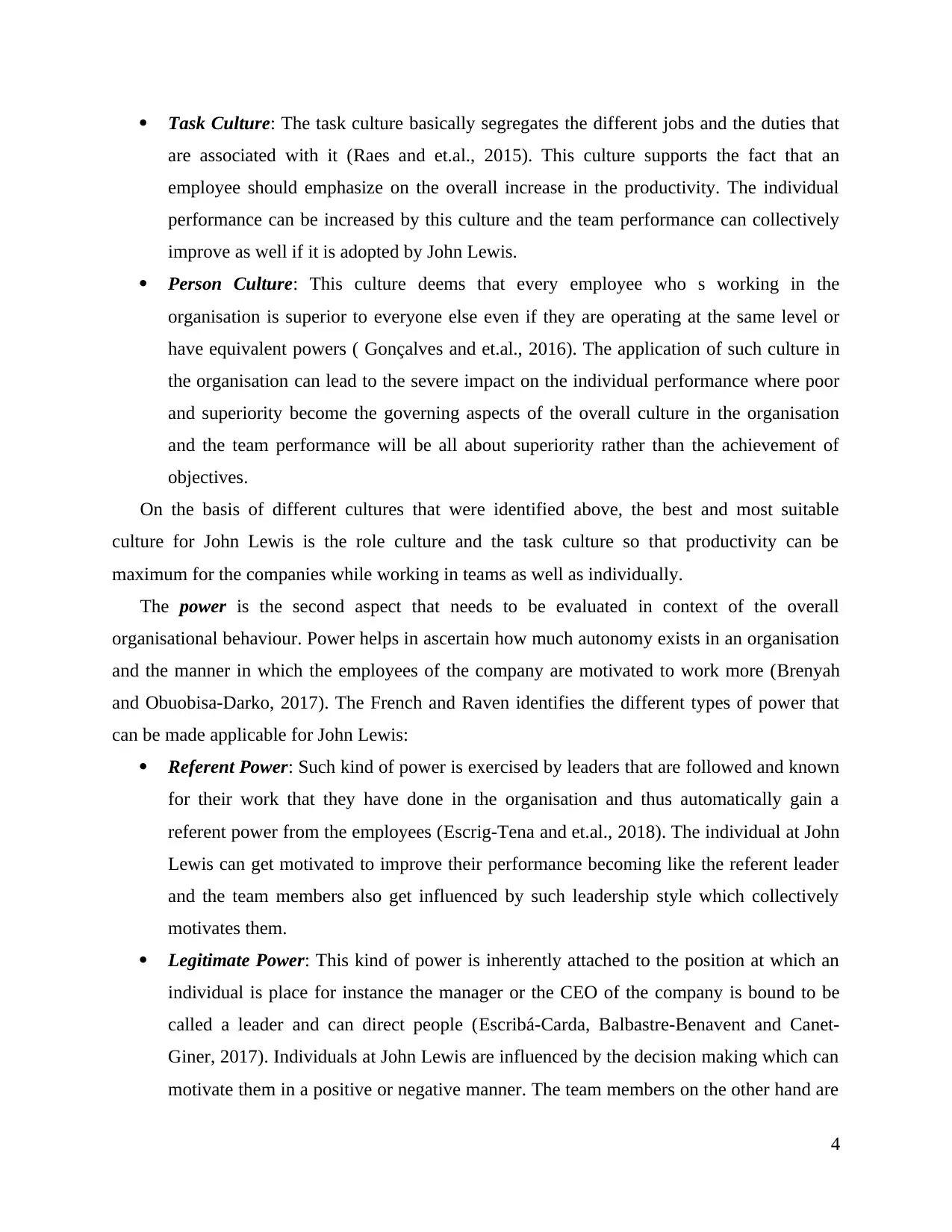
Task Culture: The task culture basically segregates the different jobs and the duties that
are associated with it (Raes and et.al., 2015). This culture supports the fact that an
employee should emphasize on the overall increase in the productivity. The individual
performance can be increased by this culture and the team performance can collectively
improve as well if it is adopted by John Lewis.
Person Culture: This culture deems that every employee who s working in the
organisation is superior to everyone else even if they are operating at the same level or
have equivalent powers ( Gonçalves and et.al., 2016). The application of such culture in
the organisation can lead to the severe impact on the individual performance where poor
and superiority become the governing aspects of the overall culture in the organisation
and the team performance will be all about superiority rather than the achievement of
objectives.
On the basis of different cultures that were identified above, the best and most suitable
culture for John Lewis is the role culture and the task culture so that productivity can be
maximum for the companies while working in teams as well as individually.
The power is the second aspect that needs to be evaluated in context of the overall
organisational behaviour. Power helps in ascertain how much autonomy exists in an organisation
and the manner in which the employees of the company are motivated to work more (Brenyah
and Obuobisa-Darko, 2017). The French and Raven identifies the different types of power that
can be made applicable for John Lewis:
Referent Power: Such kind of power is exercised by leaders that are followed and known
for their work that they have done in the organisation and thus automatically gain a
referent power from the employees (Escrig-Tena and et.al., 2018). The individual at John
Lewis can get motivated to improve their performance becoming like the referent leader
and the team members also get influenced by such leadership style which collectively
motivates them.
Legitimate Power: This kind of power is inherently attached to the position at which an
individual is place for instance the manager or the CEO of the company is bound to be
called a leader and can direct people (Escribá-Carda, Balbastre-Benavent and Canet-
Giner, 2017). Individuals at John Lewis are influenced by the decision making which can
motivate them in a positive or negative manner. The team members on the other hand are
4
are associated with it (Raes and et.al., 2015). This culture supports the fact that an
employee should emphasize on the overall increase in the productivity. The individual
performance can be increased by this culture and the team performance can collectively
improve as well if it is adopted by John Lewis.
Person Culture: This culture deems that every employee who s working in the
organisation is superior to everyone else even if they are operating at the same level or
have equivalent powers ( Gonçalves and et.al., 2016). The application of such culture in
the organisation can lead to the severe impact on the individual performance where poor
and superiority become the governing aspects of the overall culture in the organisation
and the team performance will be all about superiority rather than the achievement of
objectives.
On the basis of different cultures that were identified above, the best and most suitable
culture for John Lewis is the role culture and the task culture so that productivity can be
maximum for the companies while working in teams as well as individually.
The power is the second aspect that needs to be evaluated in context of the overall
organisational behaviour. Power helps in ascertain how much autonomy exists in an organisation
and the manner in which the employees of the company are motivated to work more (Brenyah
and Obuobisa-Darko, 2017). The French and Raven identifies the different types of power that
can be made applicable for John Lewis:
Referent Power: Such kind of power is exercised by leaders that are followed and known
for their work that they have done in the organisation and thus automatically gain a
referent power from the employees (Escrig-Tena and et.al., 2018). The individual at John
Lewis can get motivated to improve their performance becoming like the referent leader
and the team members also get influenced by such leadership style which collectively
motivates them.
Legitimate Power: This kind of power is inherently attached to the position at which an
individual is place for instance the manager or the CEO of the company is bound to be
called a leader and can direct people (Escribá-Carda, Balbastre-Benavent and Canet-
Giner, 2017). Individuals at John Lewis are influenced by the decision making which can
motivate them in a positive or negative manner. The team members on the other hand are
4
Paraphrase This Document
Need a fresh take? Get an instant paraphrase of this document with our AI Paraphraser
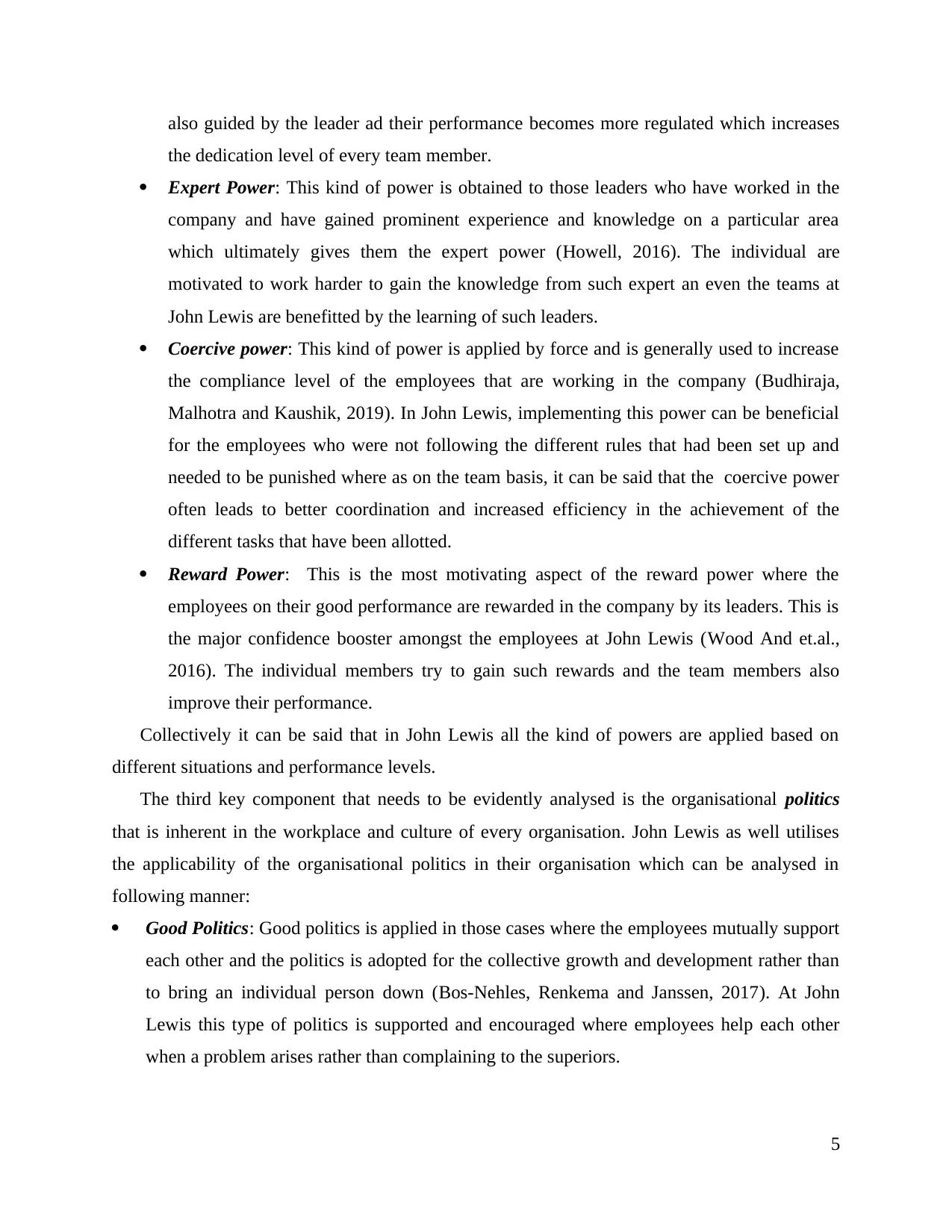
also guided by the leader ad their performance becomes more regulated which increases
the dedication level of every team member.
Expert Power: This kind of power is obtained to those leaders who have worked in the
company and have gained prominent experience and knowledge on a particular area
which ultimately gives them the expert power (Howell, 2016). The individual are
motivated to work harder to gain the knowledge from such expert an even the teams at
John Lewis are benefitted by the learning of such leaders.
Coercive power: This kind of power is applied by force and is generally used to increase
the compliance level of the employees that are working in the company (Budhiraja,
Malhotra and Kaushik, 2019). In John Lewis, implementing this power can be beneficial
for the employees who were not following the different rules that had been set up and
needed to be punished where as on the team basis, it can be said that the coercive power
often leads to better coordination and increased efficiency in the achievement of the
different tasks that have been allotted.
Reward Power: This is the most motivating aspect of the reward power where the
employees on their good performance are rewarded in the company by its leaders. This is
the major confidence booster amongst the employees at John Lewis (Wood And et.al.,
2016). The individual members try to gain such rewards and the team members also
improve their performance.
Collectively it can be said that in John Lewis all the kind of powers are applied based on
different situations and performance levels.
The third key component that needs to be evidently analysed is the organisational politics
that is inherent in the workplace and culture of every organisation. John Lewis as well utilises
the applicability of the organisational politics in their organisation which can be analysed in
following manner:
Good Politics: Good politics is applied in those cases where the employees mutually support
each other and the politics is adopted for the collective growth and development rather than
to bring an individual person down (Bos-Nehles, Renkema and Janssen, 2017). At John
Lewis this type of politics is supported and encouraged where employees help each other
when a problem arises rather than complaining to the superiors.
5
the dedication level of every team member.
Expert Power: This kind of power is obtained to those leaders who have worked in the
company and have gained prominent experience and knowledge on a particular area
which ultimately gives them the expert power (Howell, 2016). The individual are
motivated to work harder to gain the knowledge from such expert an even the teams at
John Lewis are benefitted by the learning of such leaders.
Coercive power: This kind of power is applied by force and is generally used to increase
the compliance level of the employees that are working in the company (Budhiraja,
Malhotra and Kaushik, 2019). In John Lewis, implementing this power can be beneficial
for the employees who were not following the different rules that had been set up and
needed to be punished where as on the team basis, it can be said that the coercive power
often leads to better coordination and increased efficiency in the achievement of the
different tasks that have been allotted.
Reward Power: This is the most motivating aspect of the reward power where the
employees on their good performance are rewarded in the company by its leaders. This is
the major confidence booster amongst the employees at John Lewis (Wood And et.al.,
2016). The individual members try to gain such rewards and the team members also
improve their performance.
Collectively it can be said that in John Lewis all the kind of powers are applied based on
different situations and performance levels.
The third key component that needs to be evidently analysed is the organisational politics
that is inherent in the workplace and culture of every organisation. John Lewis as well utilises
the applicability of the organisational politics in their organisation which can be analysed in
following manner:
Good Politics: Good politics is applied in those cases where the employees mutually support
each other and the politics is adopted for the collective growth and development rather than
to bring an individual person down (Bos-Nehles, Renkema and Janssen, 2017). At John
Lewis this type of politics is supported and encouraged where employees help each other
when a problem arises rather than complaining to the superiors.
5
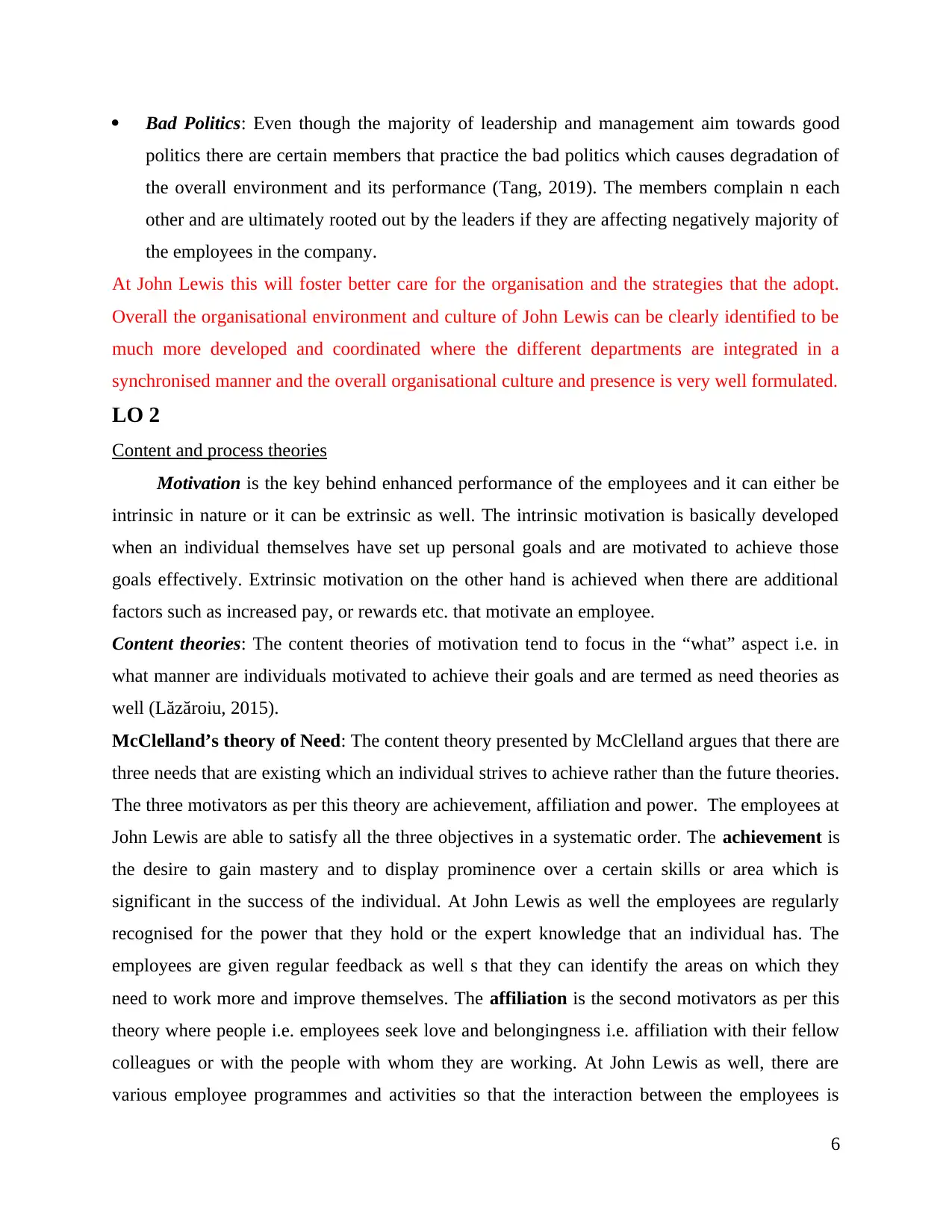
Bad Politics: Even though the majority of leadership and management aim towards good
politics there are certain members that practice the bad politics which causes degradation of
the overall environment and its performance (Tang, 2019). The members complain n each
other and are ultimately rooted out by the leaders if they are affecting negatively majority of
the employees in the company.
At John Lewis this will foster better care for the organisation and the strategies that the adopt.
Overall the organisational environment and culture of John Lewis can be clearly identified to be
much more developed and coordinated where the different departments are integrated in a
synchronised manner and the overall organisational culture and presence is very well formulated.
LO 2
Content and process theories
Motivation is the key behind enhanced performance of the employees and it can either be
intrinsic in nature or it can be extrinsic as well. The intrinsic motivation is basically developed
when an individual themselves have set up personal goals and are motivated to achieve those
goals effectively. Extrinsic motivation on the other hand is achieved when there are additional
factors such as increased pay, or rewards etc. that motivate an employee.
Content theories: The content theories of motivation tend to focus in the “what” aspect i.e. in
what manner are individuals motivated to achieve their goals and are termed as need theories as
well (Lăzăroiu, 2015).
McClelland’s theory of Need: The content theory presented by McClelland argues that there are
three needs that are existing which an individual strives to achieve rather than the future theories.
The three motivators as per this theory are achievement, affiliation and power. The employees at
John Lewis are able to satisfy all the three objectives in a systematic order. The achievement is
the desire to gain mastery and to display prominence over a certain skills or area which is
significant in the success of the individual. At John Lewis as well the employees are regularly
recognised for the power that they hold or the expert knowledge that an individual has. The
employees are given regular feedback as well s that they can identify the areas on which they
need to work more and improve themselves. The affiliation is the second motivators as per this
theory where people i.e. employees seek love and belongingness i.e. affiliation with their fellow
colleagues or with the people with whom they are working. At John Lewis as well, there are
various employee programmes and activities so that the interaction between the employees is
6
politics there are certain members that practice the bad politics which causes degradation of
the overall environment and its performance (Tang, 2019). The members complain n each
other and are ultimately rooted out by the leaders if they are affecting negatively majority of
the employees in the company.
At John Lewis this will foster better care for the organisation and the strategies that the adopt.
Overall the organisational environment and culture of John Lewis can be clearly identified to be
much more developed and coordinated where the different departments are integrated in a
synchronised manner and the overall organisational culture and presence is very well formulated.
LO 2
Content and process theories
Motivation is the key behind enhanced performance of the employees and it can either be
intrinsic in nature or it can be extrinsic as well. The intrinsic motivation is basically developed
when an individual themselves have set up personal goals and are motivated to achieve those
goals effectively. Extrinsic motivation on the other hand is achieved when there are additional
factors such as increased pay, or rewards etc. that motivate an employee.
Content theories: The content theories of motivation tend to focus in the “what” aspect i.e. in
what manner are individuals motivated to achieve their goals and are termed as need theories as
well (Lăzăroiu, 2015).
McClelland’s theory of Need: The content theory presented by McClelland argues that there are
three needs that are existing which an individual strives to achieve rather than the future theories.
The three motivators as per this theory are achievement, affiliation and power. The employees at
John Lewis are able to satisfy all the three objectives in a systematic order. The achievement is
the desire to gain mastery and to display prominence over a certain skills or area which is
significant in the success of the individual. At John Lewis as well the employees are regularly
recognised for the power that they hold or the expert knowledge that an individual has. The
employees are given regular feedback as well s that they can identify the areas on which they
need to work more and improve themselves. The affiliation is the second motivators as per this
theory where people i.e. employees seek love and belongingness i.e. affiliation with their fellow
colleagues or with the people with whom they are working. At John Lewis as well, there are
various employee programmes and activities so that the interaction between the employees is
6
⊘ This is a preview!⊘
Do you want full access?
Subscribe today to unlock all pages.

Trusted by 1+ million students worldwide
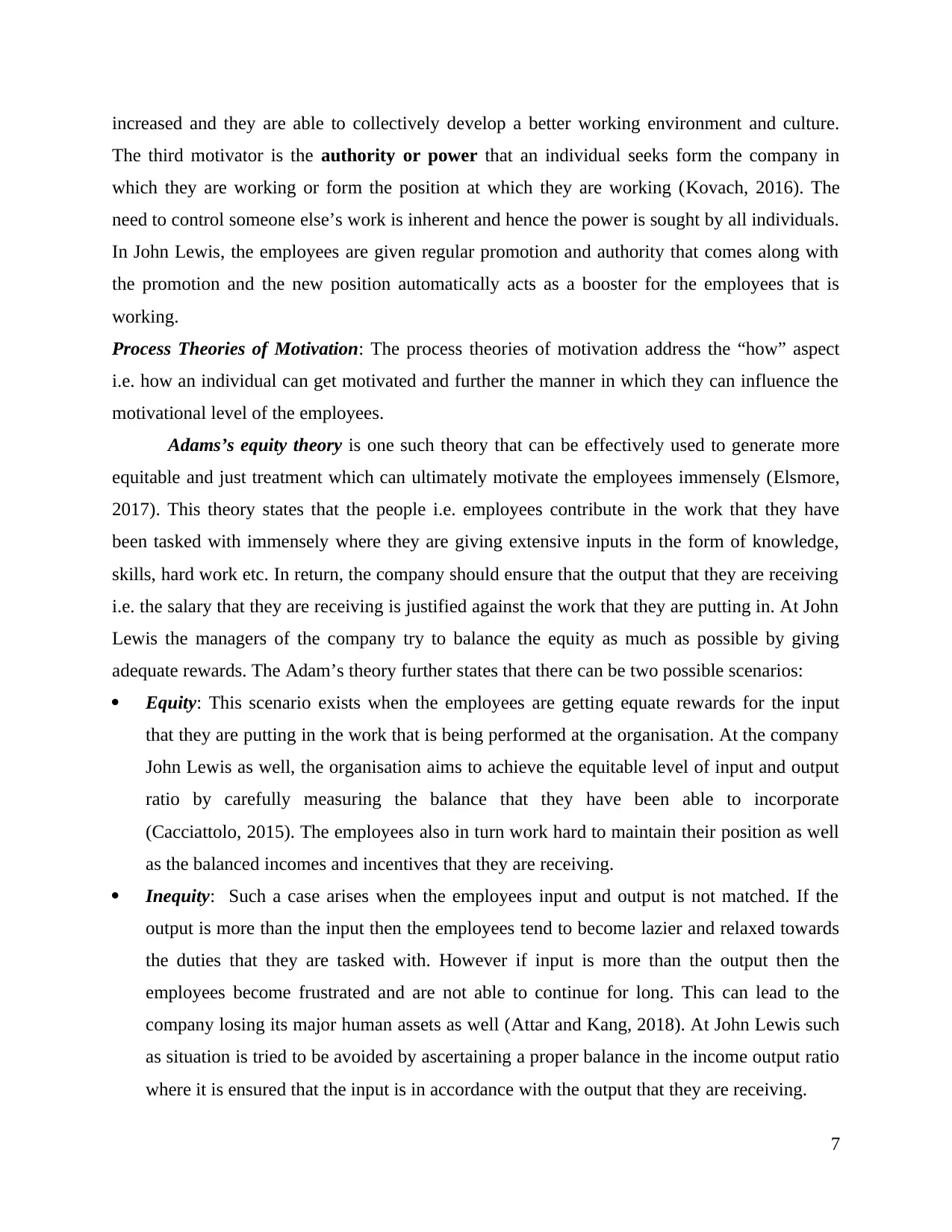
increased and they are able to collectively develop a better working environment and culture.
The third motivator is the authority or power that an individual seeks form the company in
which they are working or form the position at which they are working (Kovach, 2016). The
need to control someone else’s work is inherent and hence the power is sought by all individuals.
In John Lewis, the employees are given regular promotion and authority that comes along with
the promotion and the new position automatically acts as a booster for the employees that is
working.
Process Theories of Motivation: The process theories of motivation address the “how” aspect
i.e. how an individual can get motivated and further the manner in which they can influence the
motivational level of the employees.
Adams’s equity theory is one such theory that can be effectively used to generate more
equitable and just treatment which can ultimately motivate the employees immensely (Elsmore,
2017). This theory states that the people i.e. employees contribute in the work that they have
been tasked with immensely where they are giving extensive inputs in the form of knowledge,
skills, hard work etc. In return, the company should ensure that the output that they are receiving
i.e. the salary that they are receiving is justified against the work that they are putting in. At John
Lewis the managers of the company try to balance the equity as much as possible by giving
adequate rewards. The Adam’s theory further states that there can be two possible scenarios:
Equity: This scenario exists when the employees are getting equate rewards for the input
that they are putting in the work that is being performed at the organisation. At the company
John Lewis as well, the organisation aims to achieve the equitable level of input and output
ratio by carefully measuring the balance that they have been able to incorporate
(Cacciattolo, 2015). The employees also in turn work hard to maintain their position as well
as the balanced incomes and incentives that they are receiving.
Inequity: Such a case arises when the employees input and output is not matched. If the
output is more than the input then the employees tend to become lazier and relaxed towards
the duties that they are tasked with. However if input is more than the output then the
employees become frustrated and are not able to continue for long. This can lead to the
company losing its major human assets as well (Attar and Kang, 2018). At John Lewis such
as situation is tried to be avoided by ascertaining a proper balance in the income output ratio
where it is ensured that the input is in accordance with the output that they are receiving.
7
The third motivator is the authority or power that an individual seeks form the company in
which they are working or form the position at which they are working (Kovach, 2016). The
need to control someone else’s work is inherent and hence the power is sought by all individuals.
In John Lewis, the employees are given regular promotion and authority that comes along with
the promotion and the new position automatically acts as a booster for the employees that is
working.
Process Theories of Motivation: The process theories of motivation address the “how” aspect
i.e. how an individual can get motivated and further the manner in which they can influence the
motivational level of the employees.
Adams’s equity theory is one such theory that can be effectively used to generate more
equitable and just treatment which can ultimately motivate the employees immensely (Elsmore,
2017). This theory states that the people i.e. employees contribute in the work that they have
been tasked with immensely where they are giving extensive inputs in the form of knowledge,
skills, hard work etc. In return, the company should ensure that the output that they are receiving
i.e. the salary that they are receiving is justified against the work that they are putting in. At John
Lewis the managers of the company try to balance the equity as much as possible by giving
adequate rewards. The Adam’s theory further states that there can be two possible scenarios:
Equity: This scenario exists when the employees are getting equate rewards for the input
that they are putting in the work that is being performed at the organisation. At the company
John Lewis as well, the organisation aims to achieve the equitable level of input and output
ratio by carefully measuring the balance that they have been able to incorporate
(Cacciattolo, 2015). The employees also in turn work hard to maintain their position as well
as the balanced incomes and incentives that they are receiving.
Inequity: Such a case arises when the employees input and output is not matched. If the
output is more than the input then the employees tend to become lazier and relaxed towards
the duties that they are tasked with. However if input is more than the output then the
employees become frustrated and are not able to continue for long. This can lead to the
company losing its major human assets as well (Attar and Kang, 2018). At John Lewis such
as situation is tried to be avoided by ascertaining a proper balance in the income output ratio
where it is ensured that the input is in accordance with the output that they are receiving.
7
Paraphrase This Document
Need a fresh take? Get an instant paraphrase of this document with our AI Paraphraser
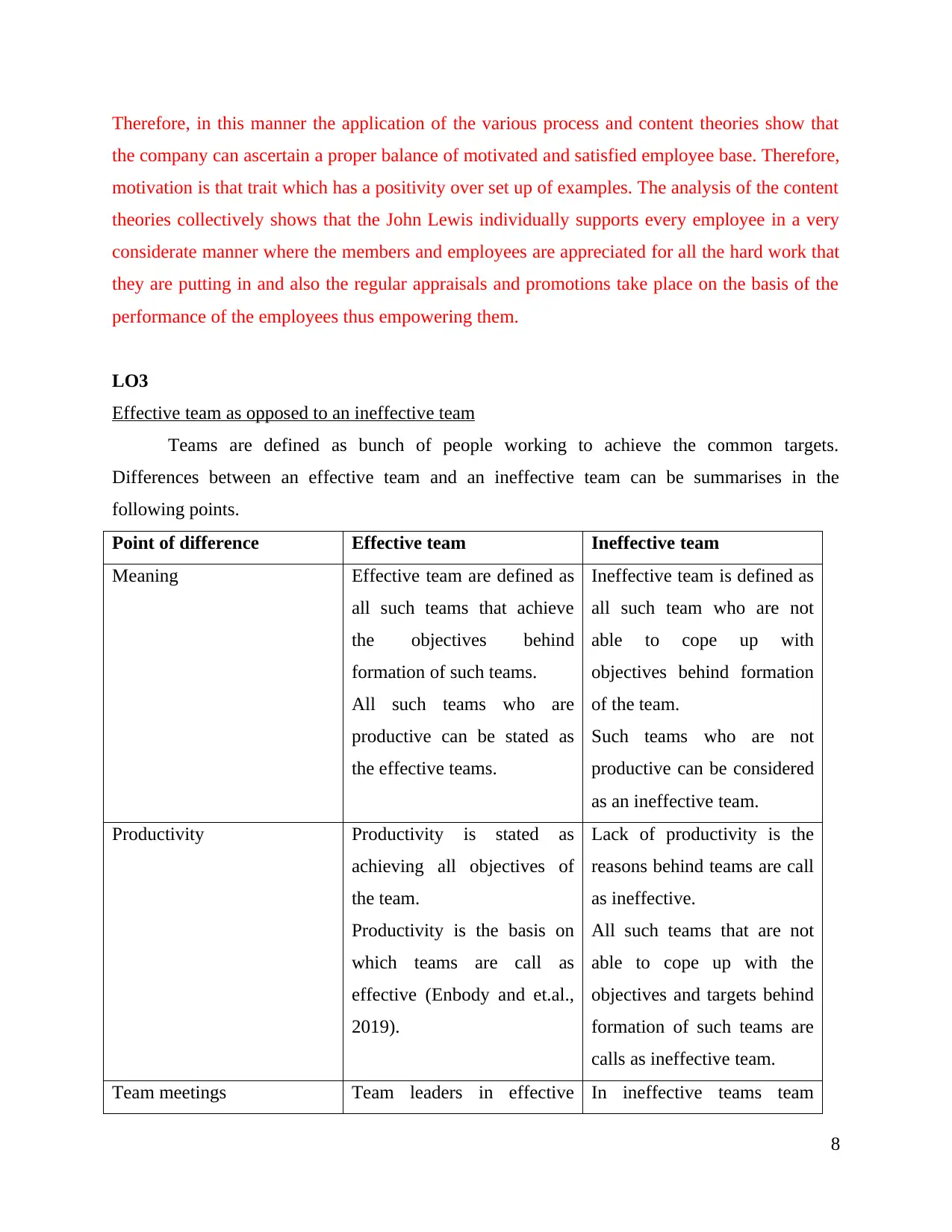
Therefore, in this manner the application of the various process and content theories show that
the company can ascertain a proper balance of motivated and satisfied employee base. Therefore,
motivation is that trait which has a positivity over set up of examples. The analysis of the content
theories collectively shows that the John Lewis individually supports every employee in a very
considerate manner where the members and employees are appreciated for all the hard work that
they are putting in and also the regular appraisals and promotions take place on the basis of the
performance of the employees thus empowering them.
LO3
Effective team as opposed to an ineffective team
Teams are defined as bunch of people working to achieve the common targets.
Differences between an effective team and an ineffective team can be summarises in the
following points.
Point of difference Effective team Ineffective team
Meaning Effective team are defined as
all such teams that achieve
the objectives behind
formation of such teams.
All such teams who are
productive can be stated as
the effective teams.
Ineffective team is defined as
all such team who are not
able to cope up with
objectives behind formation
of the team.
Such teams who are not
productive can be considered
as an ineffective team.
Productivity Productivity is stated as
achieving all objectives of
the team.
Productivity is the basis on
which teams are call as
effective (Enbody and et.al.,
2019).
Lack of productivity is the
reasons behind teams are call
as ineffective.
All such teams that are not
able to cope up with the
objectives and targets behind
formation of such teams are
calls as ineffective team.
Team meetings Team leaders in effective In ineffective teams team
8
the company can ascertain a proper balance of motivated and satisfied employee base. Therefore,
motivation is that trait which has a positivity over set up of examples. The analysis of the content
theories collectively shows that the John Lewis individually supports every employee in a very
considerate manner where the members and employees are appreciated for all the hard work that
they are putting in and also the regular appraisals and promotions take place on the basis of the
performance of the employees thus empowering them.
LO3
Effective team as opposed to an ineffective team
Teams are defined as bunch of people working to achieve the common targets.
Differences between an effective team and an ineffective team can be summarises in the
following points.
Point of difference Effective team Ineffective team
Meaning Effective team are defined as
all such teams that achieve
the objectives behind
formation of such teams.
All such teams who are
productive can be stated as
the effective teams.
Ineffective team is defined as
all such team who are not
able to cope up with
objectives behind formation
of the team.
Such teams who are not
productive can be considered
as an ineffective team.
Productivity Productivity is stated as
achieving all objectives of
the team.
Productivity is the basis on
which teams are call as
effective (Enbody and et.al.,
2019).
Lack of productivity is the
reasons behind teams are call
as ineffective.
All such teams that are not
able to cope up with the
objectives and targets behind
formation of such teams are
calls as ineffective team.
Team meetings Team leaders in effective In ineffective teams team
8
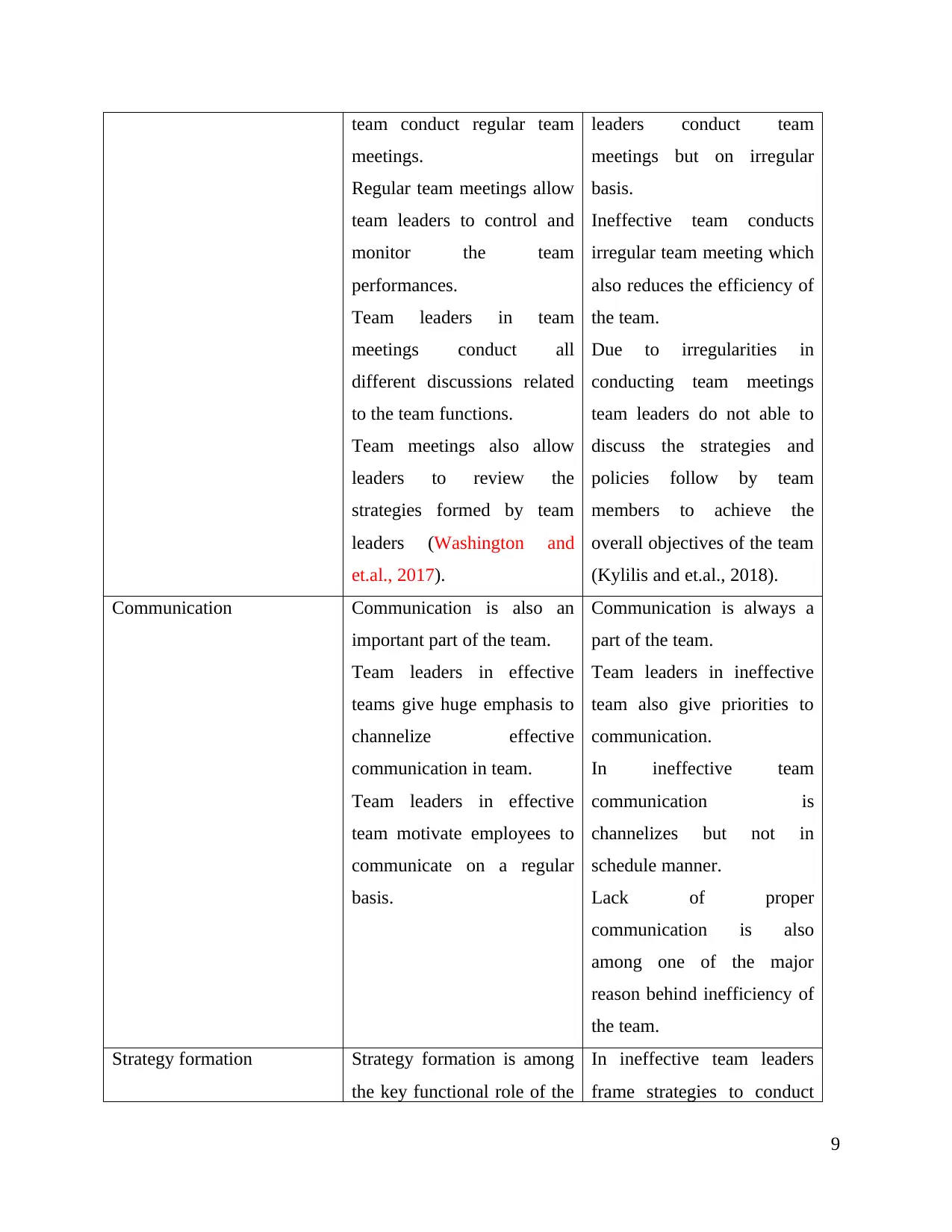
team conduct regular team
meetings.
Regular team meetings allow
team leaders to control and
monitor the team
performances.
Team leaders in team
meetings conduct all
different discussions related
to the team functions.
Team meetings also allow
leaders to review the
strategies formed by team
leaders (Washington and
et.al., 2017).
leaders conduct team
meetings but on irregular
basis.
Ineffective team conducts
irregular team meeting which
also reduces the efficiency of
the team.
Due to irregularities in
conducting team meetings
team leaders do not able to
discuss the strategies and
policies follow by team
members to achieve the
overall objectives of the team
(Kylilis and et.al., 2018).
Communication Communication is also an
important part of the team.
Team leaders in effective
teams give huge emphasis to
channelize effective
communication in team.
Team leaders in effective
team motivate employees to
communicate on a regular
basis.
Communication is always a
part of the team.
Team leaders in ineffective
team also give priorities to
communication.
In ineffective team
communication is
channelizes but not in
schedule manner.
Lack of proper
communication is also
among one of the major
reason behind inefficiency of
the team.
Strategy formation Strategy formation is among
the key functional role of the
In ineffective team leaders
frame strategies to conduct
9
meetings.
Regular team meetings allow
team leaders to control and
monitor the team
performances.
Team leaders in team
meetings conduct all
different discussions related
to the team functions.
Team meetings also allow
leaders to review the
strategies formed by team
leaders (Washington and
et.al., 2017).
leaders conduct team
meetings but on irregular
basis.
Ineffective team conducts
irregular team meeting which
also reduces the efficiency of
the team.
Due to irregularities in
conducting team meetings
team leaders do not able to
discuss the strategies and
policies follow by team
members to achieve the
overall objectives of the team
(Kylilis and et.al., 2018).
Communication Communication is also an
important part of the team.
Team leaders in effective
teams give huge emphasis to
channelize effective
communication in team.
Team leaders in effective
team motivate employees to
communicate on a regular
basis.
Communication is always a
part of the team.
Team leaders in ineffective
team also give priorities to
communication.
In ineffective team
communication is
channelizes but not in
schedule manner.
Lack of proper
communication is also
among one of the major
reason behind inefficiency of
the team.
Strategy formation Strategy formation is among
the key functional role of the
In ineffective team leaders
frame strategies to conduct
9
⊘ This is a preview!⊘
Do you want full access?
Subscribe today to unlock all pages.

Trusted by 1+ million students worldwide
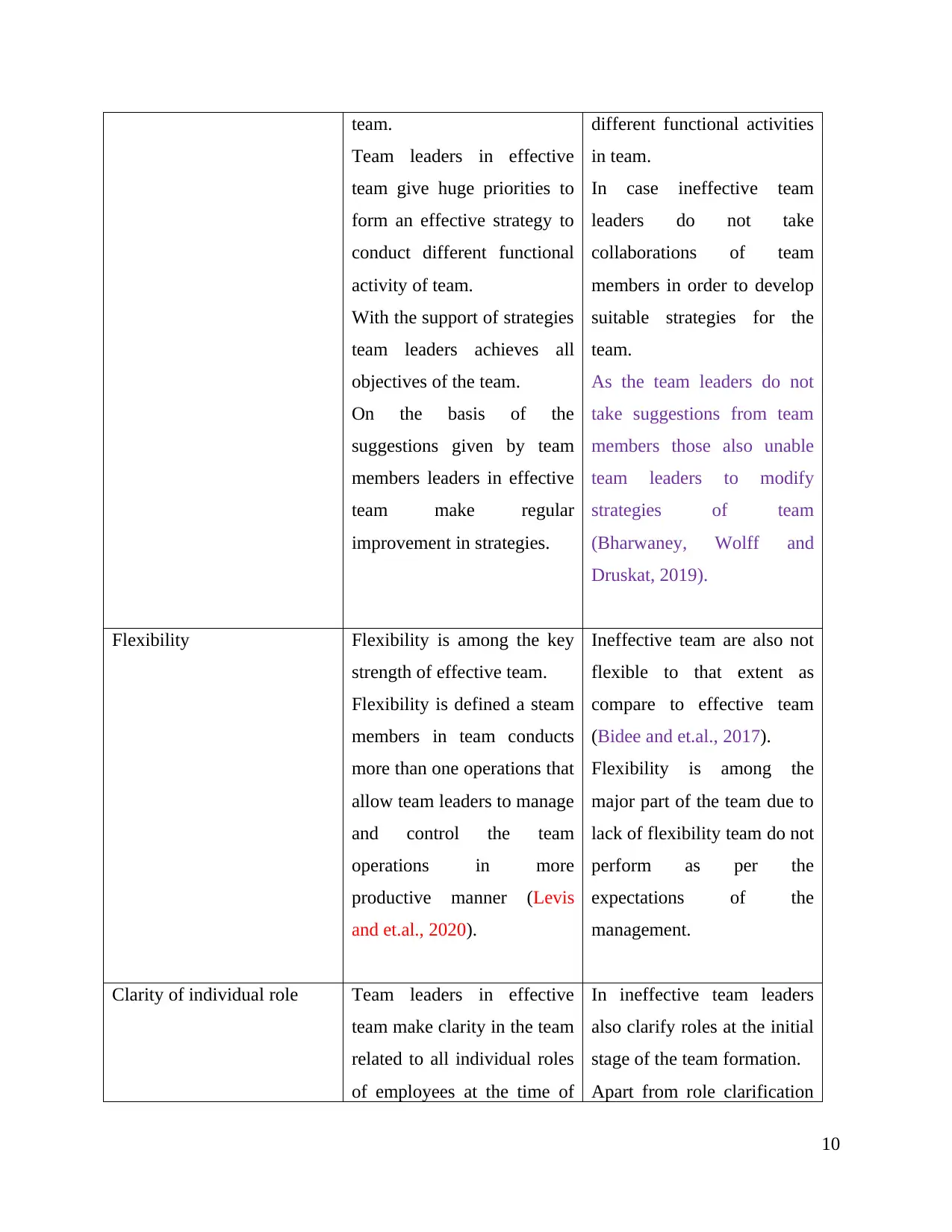
team.
Team leaders in effective
team give huge priorities to
form an effective strategy to
conduct different functional
activity of team.
With the support of strategies
team leaders achieves all
objectives of the team.
On the basis of the
suggestions given by team
members leaders in effective
team make regular
improvement in strategies.
different functional activities
in team.
In case ineffective team
leaders do not take
collaborations of team
members in order to develop
suitable strategies for the
team.
As the team leaders do not
take suggestions from team
members those also unable
team leaders to modify
strategies of team
(Bharwaney, Wolff and
Druskat, 2019).
Flexibility Flexibility is among the key
strength of effective team.
Flexibility is defined a steam
members in team conducts
more than one operations that
allow team leaders to manage
and control the team
operations in more
productive manner (Levis
and et.al., 2020).
Ineffective team are also not
flexible to that extent as
compare to effective team
(Bidee and et.al., 2017).
Flexibility is among the
major part of the team due to
lack of flexibility team do not
perform as per the
expectations of the
management.
Clarity of individual role Team leaders in effective
team make clarity in the team
related to all individual roles
of employees at the time of
In ineffective team leaders
also clarify roles at the initial
stage of the team formation.
Apart from role clarification
10
Team leaders in effective
team give huge priorities to
form an effective strategy to
conduct different functional
activity of team.
With the support of strategies
team leaders achieves all
objectives of the team.
On the basis of the
suggestions given by team
members leaders in effective
team make regular
improvement in strategies.
different functional activities
in team.
In case ineffective team
leaders do not take
collaborations of team
members in order to develop
suitable strategies for the
team.
As the team leaders do not
take suggestions from team
members those also unable
team leaders to modify
strategies of team
(Bharwaney, Wolff and
Druskat, 2019).
Flexibility Flexibility is among the key
strength of effective team.
Flexibility is defined a steam
members in team conducts
more than one operations that
allow team leaders to manage
and control the team
operations in more
productive manner (Levis
and et.al., 2020).
Ineffective team are also not
flexible to that extent as
compare to effective team
(Bidee and et.al., 2017).
Flexibility is among the
major part of the team due to
lack of flexibility team do not
perform as per the
expectations of the
management.
Clarity of individual role Team leaders in effective
team make clarity in the team
related to all individual roles
of employees at the time of
In ineffective team leaders
also clarify roles at the initial
stage of the team formation.
Apart from role clarification
10
Paraphrase This Document
Need a fresh take? Get an instant paraphrase of this document with our AI Paraphraser
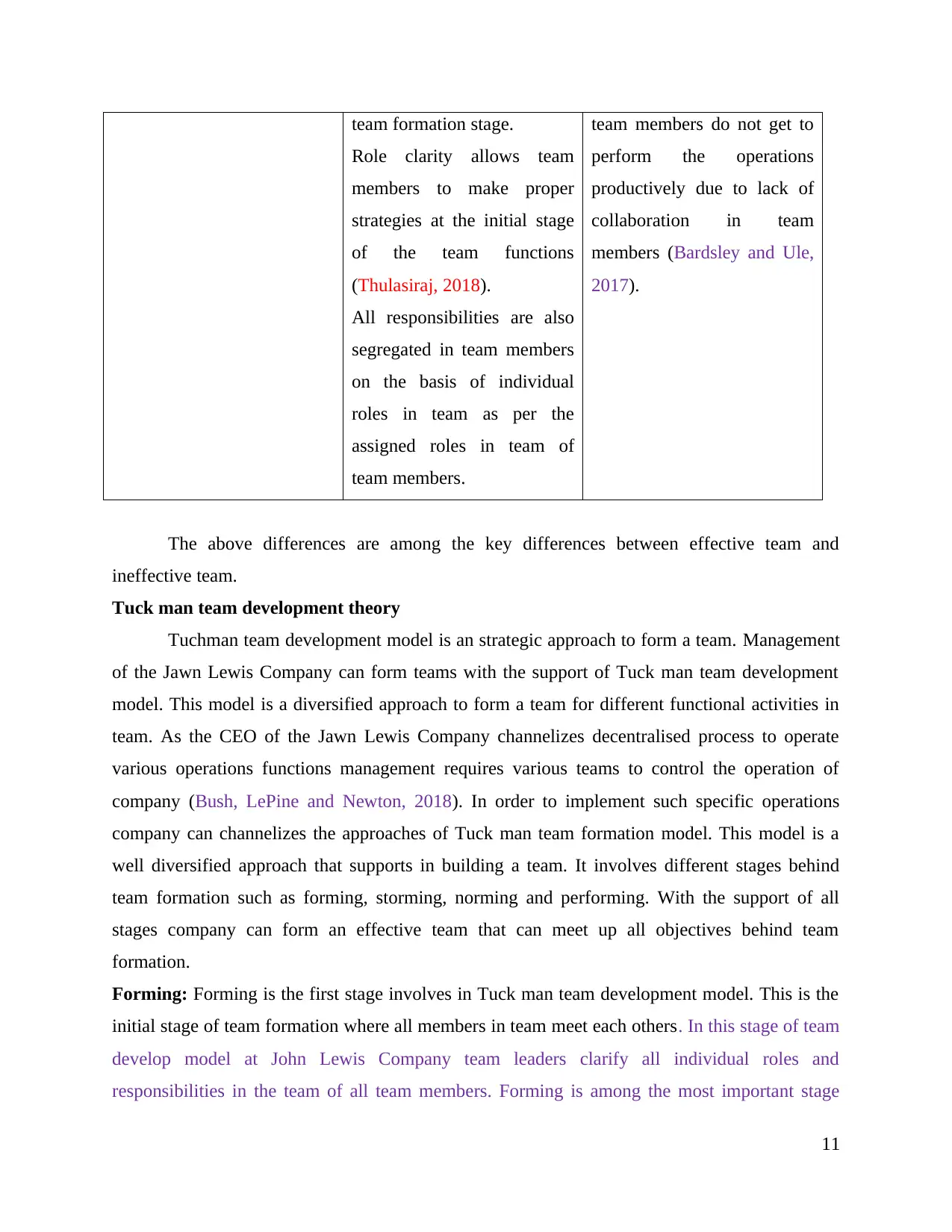
team formation stage.
Role clarity allows team
members to make proper
strategies at the initial stage
of the team functions
(Thulasiraj, 2018).
All responsibilities are also
segregated in team members
on the basis of individual
roles in team as per the
assigned roles in team of
team members.
team members do not get to
perform the operations
productively due to lack of
collaboration in team
members (Bardsley and Ule,
2017).
The above differences are among the key differences between effective team and
ineffective team.
Tuck man team development theory
Tuchman team development model is an strategic approach to form a team. Management
of the Jawn Lewis Company can form teams with the support of Tuck man team development
model. This model is a diversified approach to form a team for different functional activities in
team. As the CEO of the Jawn Lewis Company channelizes decentralised process to operate
various operations functions management requires various teams to control the operation of
company (Bush, LePine and Newton, 2018). In order to implement such specific operations
company can channelizes the approaches of Tuck man team formation model. This model is a
well diversified approach that supports in building a team. It involves different stages behind
team formation such as forming, storming, norming and performing. With the support of all
stages company can form an effective team that can meet up all objectives behind team
formation.
Forming: Forming is the first stage involves in Tuck man team development model. This is the
initial stage of team formation where all members in team meet each others. In this stage of team
develop model at John Lewis Company team leaders clarify all individual roles and
responsibilities in the team of all team members. Forming is among the most important stage
11
Role clarity allows team
members to make proper
strategies at the initial stage
of the team functions
(Thulasiraj, 2018).
All responsibilities are also
segregated in team members
on the basis of individual
roles in team as per the
assigned roles in team of
team members.
team members do not get to
perform the operations
productively due to lack of
collaboration in team
members (Bardsley and Ule,
2017).
The above differences are among the key differences between effective team and
ineffective team.
Tuck man team development theory
Tuchman team development model is an strategic approach to form a team. Management
of the Jawn Lewis Company can form teams with the support of Tuck man team development
model. This model is a diversified approach to form a team for different functional activities in
team. As the CEO of the Jawn Lewis Company channelizes decentralised process to operate
various operations functions management requires various teams to control the operation of
company (Bush, LePine and Newton, 2018). In order to implement such specific operations
company can channelizes the approaches of Tuck man team formation model. This model is a
well diversified approach that supports in building a team. It involves different stages behind
team formation such as forming, storming, norming and performing. With the support of all
stages company can form an effective team that can meet up all objectives behind team
formation.
Forming: Forming is the first stage involves in Tuck man team development model. This is the
initial stage of team formation where all members in team meet each others. In this stage of team
develop model at John Lewis Company team leaders clarify all individual roles and
responsibilities in the team of all team members. Forming is among the most important stage
11
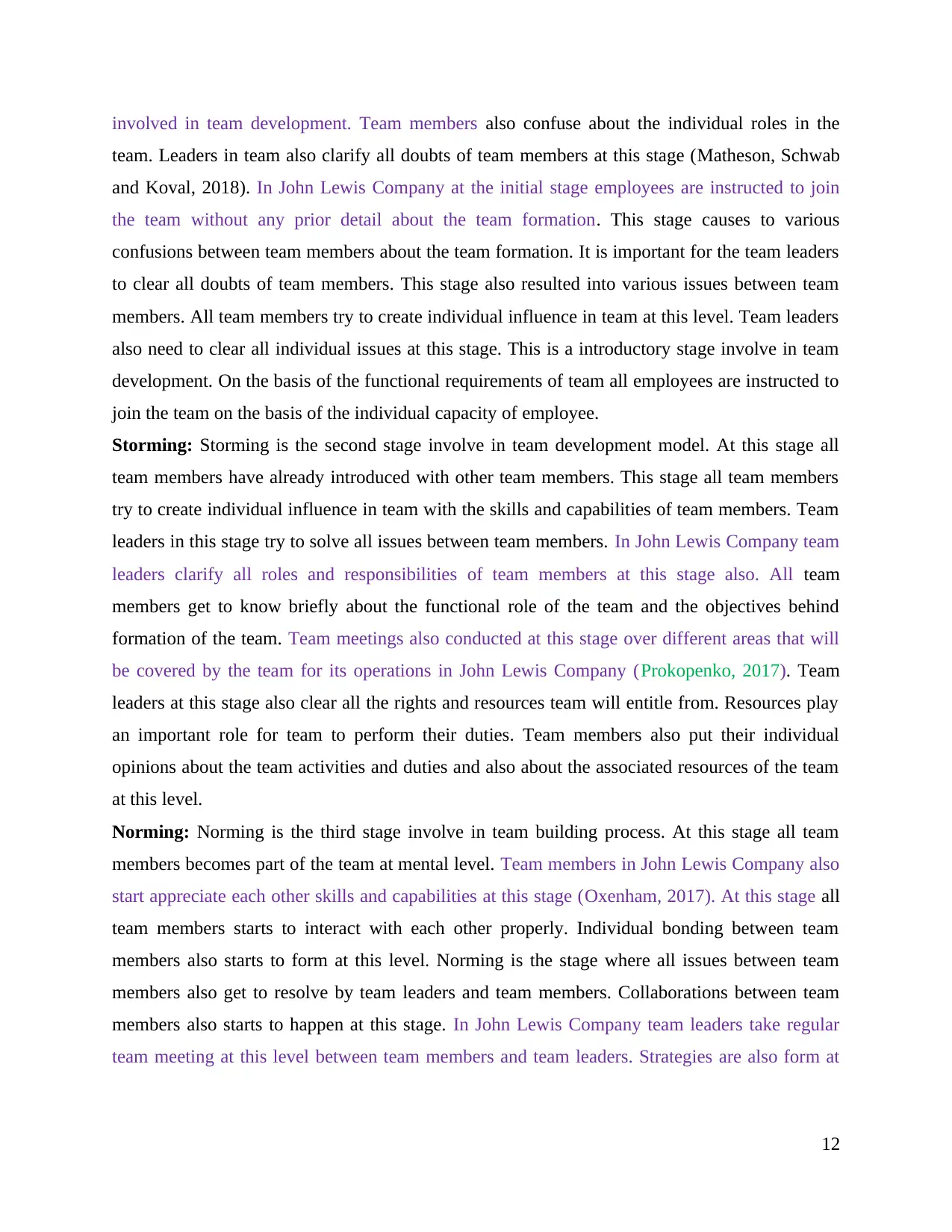
involved in team development. Team members also confuse about the individual roles in the
team. Leaders in team also clarify all doubts of team members at this stage (Matheson, Schwab
and Koval, 2018). In John Lewis Company at the initial stage employees are instructed to join
the team without any prior detail about the team formation. This stage causes to various
confusions between team members about the team formation. It is important for the team leaders
to clear all doubts of team members. This stage also resulted into various issues between team
members. All team members try to create individual influence in team at this level. Team leaders
also need to clear all individual issues at this stage. This is a introductory stage involve in team
development. On the basis of the functional requirements of team all employees are instructed to
join the team on the basis of the individual capacity of employee.
Storming: Storming is the second stage involve in team development model. At this stage all
team members have already introduced with other team members. This stage all team members
try to create individual influence in team with the skills and capabilities of team members. Team
leaders in this stage try to solve all issues between team members. In John Lewis Company team
leaders clarify all roles and responsibilities of team members at this stage also. All team
members get to know briefly about the functional role of the team and the objectives behind
formation of the team. Team meetings also conducted at this stage over different areas that will
be covered by the team for its operations in John Lewis Company (Prokopenko, 2017). Team
leaders at this stage also clear all the rights and resources team will entitle from. Resources play
an important role for team to perform their duties. Team members also put their individual
opinions about the team activities and duties and also about the associated resources of the team
at this level.
Norming: Norming is the third stage involve in team building process. At this stage all team
members becomes part of the team at mental level. Team members in John Lewis Company also
start appreciate each other skills and capabilities at this stage (Oxenham, 2017). At this stage all
team members starts to interact with each other properly. Individual bonding between team
members also starts to form at this level. Norming is the stage where all issues between team
members also get to resolve by team leaders and team members. Collaborations between team
members also starts to happen at this stage. In John Lewis Company team leaders take regular
team meeting at this level between team members and team leaders. Strategies are also form at
12
team. Leaders in team also clarify all doubts of team members at this stage (Matheson, Schwab
and Koval, 2018). In John Lewis Company at the initial stage employees are instructed to join
the team without any prior detail about the team formation. This stage causes to various
confusions between team members about the team formation. It is important for the team leaders
to clear all doubts of team members. This stage also resulted into various issues between team
members. All team members try to create individual influence in team at this level. Team leaders
also need to clear all individual issues at this stage. This is a introductory stage involve in team
development. On the basis of the functional requirements of team all employees are instructed to
join the team on the basis of the individual capacity of employee.
Storming: Storming is the second stage involve in team development model. At this stage all
team members have already introduced with other team members. This stage all team members
try to create individual influence in team with the skills and capabilities of team members. Team
leaders in this stage try to solve all issues between team members. In John Lewis Company team
leaders clarify all roles and responsibilities of team members at this stage also. All team
members get to know briefly about the functional role of the team and the objectives behind
formation of the team. Team meetings also conducted at this stage over different areas that will
be covered by the team for its operations in John Lewis Company (Prokopenko, 2017). Team
leaders at this stage also clear all the rights and resources team will entitle from. Resources play
an important role for team to perform their duties. Team members also put their individual
opinions about the team activities and duties and also about the associated resources of the team
at this level.
Norming: Norming is the third stage involve in team building process. At this stage all team
members becomes part of the team at mental level. Team members in John Lewis Company also
start appreciate each other skills and capabilities at this stage (Oxenham, 2017). At this stage all
team members starts to interact with each other properly. Individual bonding between team
members also starts to form at this level. Norming is the stage where all issues between team
members also get to resolve by team leaders and team members. Collaborations between team
members also starts to happen at this stage. In John Lewis Company team leaders take regular
team meeting at this level between team members and team leaders. Strategies are also form at
12
⊘ This is a preview!⊘
Do you want full access?
Subscribe today to unlock all pages.

Trusted by 1+ million students worldwide
1 out of 20
Related Documents
Your All-in-One AI-Powered Toolkit for Academic Success.
+13062052269
info@desklib.com
Available 24*7 on WhatsApp / Email
![[object Object]](/_next/static/media/star-bottom.7253800d.svg)
Unlock your academic potential
Copyright © 2020–2025 A2Z Services. All Rights Reserved. Developed and managed by ZUCOL.





